
|
|

April 13, 2007
The Big Trip 2006, Part X: Spokane and Points West
Once every year or so, when finances and schedules permit, your editor and a couple of his similarly-obsessed radio pals get together to spend a week or so exploring a corner of our great nation, packing our schedules as full as possible to visit as many interesting broadcast facilities as we can.
And then, a few months later, once we've caught our breath (and some much-needed sleep), we share it all with you here on Tower Site of the Week (and in audio form over on Tophour.com) in a feature we call "The Big Trip."
The 2006 version of the Big Trip began and ended in Seattle, and along the way took us as far south as Eugene, Oregon and as far east as Coeur d'Alene, Idaho.
 Day
Seven - Wednesday, September 27
Day
Seven - Wednesday, September 27
After the extensive touring we did in Oregon, the first new state of our trip, our brief foray into Idaho was almost cheating, as we got an early start east out of Spokane for the short drive through Spokane Valley over the state line (18 miles away) into Coeur d'Alene, a pretty little lakeside town that serves as the commercial hub for Idaho's northern panhandle.
Alas, we have not even a single Idaho tower to show you as a result; Coeur d'Alene is very much a satellite of the Spokane radio and TV market, with just a few inaccessible mountaintop FM and TV translator sites and one AM, KVNI (1080), that's way over on the other side of Lake Coeur d'Alene and difficult to get to.
So we settle for breakfast with a friend of one of the Big Trip travelers and her family before we turn west for good, crossing back over the line into Washington after just an hour and a half in Idaho. (We'll be fixing that in a big way this fall...stay tuned for the announcement of Big Trip 2007, very soon.)
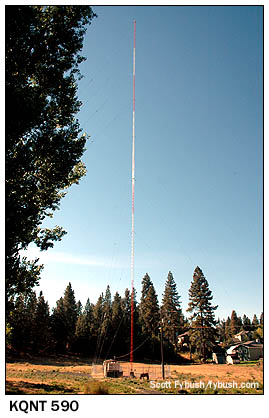 The
mountains that surround us as we cross back into Washington are
home to a few more FM sites that we don't have time to reach
(or easy access to, for that matter.)
The
mountains that surround us as we cross back into Washington are
home to a few more FM sites that we don't have time to reach
(or easy access to, for that matter.)
Mica Peak, south of I-90 on the state line, has public radio KPBX (91.1), as well as KDRK (93.7), KIXZ (96.1) and KMBI-FM (107.9), all big class C facilities. KEZE (96.9) is on Antoine Peak, north of I-90 overlooking Spokane Valley. But we're headed just a little further west, into the eastern Spokane suburb of Dishman and down Dishman Mica Road, on the back side of Krell Hill.
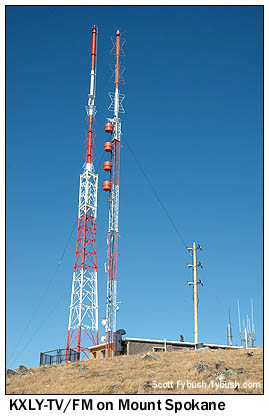 That's
where we find the new (1993) site for Spokane's 590, which was
KHQ for most of its life. When it parted ways with KHQ-TV, the
radio station became first KAQQ, then KQNT, and it's now Clear
Channel's news-talk competitor to Citadel's KGA. At 408 feet,
its new tower is still pretty impressive, but a far cry from
the 826-foot Franklin that KHQ used when it was over on Regal
Street for all those years.
That's
where we find the new (1993) site for Spokane's 590, which was
KHQ for most of its life. When it parted ways with KHQ-TV, the
radio station became first KAQQ, then KQNT, and it's now Clear
Channel's news-talk competitor to Citadel's KGA. At 408 feet,
its new tower is still pretty impressive, but a far cry from
the 826-foot Franklin that KHQ used when it was over on Regal
Street for all those years.
This site has a long history before KAQQ's arrival; for many years, it was the transmitter site for KZUN (630 Opportunity), one of two local stations serving Spokane Valley. KZUN later became KKPL, KHDR and KKPL again before going silent in 1993. (As we showed you in last week's installment, 630 later returned as a diplex on KXLY's Moran Prairie tower.)
The other AM in Spokane Valley - KSVY on 1550 - is now defunct as well, and I'm not sure anything at all is left to show for them. So we instead begin heading north, making the long drive up to Mount Spokane State Park and the remote, but easily accessible, site of KXLY-TV (Channel 4) and KXLY-FM (99.9).
KXLY-TV was Spokane's second TV station, signing on in 1953, a few months after KHQ-TV. While KHQ was then on its tall AM tower down in Moran Prairie, KXLY looked to the future, building up on Mount Spokane's 5867' peak with the idea that other TV stations would eventually follow.
Instead, KREM (Channel 2) came on the next year from the top of its AM tower in Moran Prairie, and it and KHQ eventually built taller TV towers on Krell Hill to the south rather than on Mount Spokane to the north. As a result, while KXLY had impressive reach from the mountain, it was in the wrong direction for people with fixed antennas pointed at Krell Hill. So KXLY put a channel 11 translator up on Krell, which eventually morphed into today's KXMN-LP, the My Network TV affiliate that's a sister station to KXLY. (And a neat one at that - it does a KXLY-produced morning show and 10 PM newscast, as well as an afternoon simulcast of the sports talk show from sister radio station KXLX 700.)
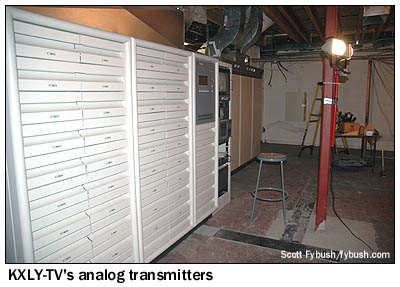
|
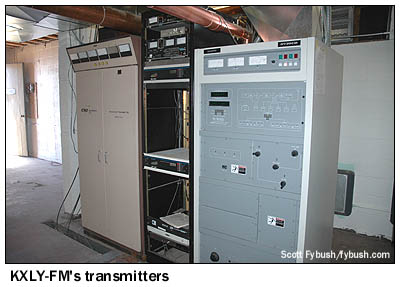
|
We expected to find a transmitter building locked up tight, but it turns out that there's a crew up here working to repair some pretty nasty ice damage that ripped right through the roof and the entire top floor of the transmitter building, and some engineers keeping tabs on the work, so we get a tour of the building. Upstairs, there are microwave dishes pointed back into town at the studio, as well as living quarters from the days when there were engineers permanently stationed up here. Downstairs, there's an older NEC and newer Harris analog transmitter, plus the Axcera transmitter for KXLY-DT (Channel 13) and the transmitters for KXLY-FM (99.9), with the current Harris keeping company with a rare CSI transmitter for backup. ("CSI: Spokane"? No, KXLY hasn't been a CBS affiliate since 1976; it's now an ABC outlet!)
One more note here: in addition to KXLY-FM's main four-bay antenna on one of the two tall towers here, the FM station has an unusual three-bay European-style antenna on a short pole next to the transmitter building. Can anyone identify it? I sure can't.
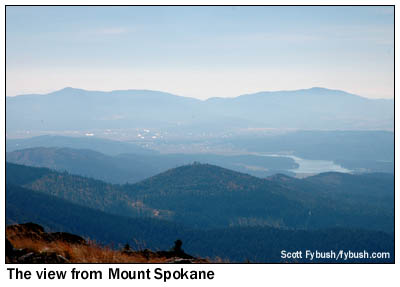
|
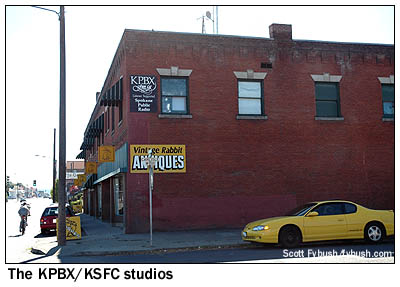
|
The long drive back down from the mountain goes southwest on route 206, then south on US 2/US 395, better known as North Division Street, the main drag through Spokane's north side. Before we make it all the way back downtown, we head a few blocks west to 2319 N. Monroe, the home of Spokane's public radio stations, KPBX (91.1) and its low-power sister, KSFC (91.9). KPBX began as a 10-watt community station before turning pro, as it were, in 1980; it's now working on a move to a more spacious studio facility.
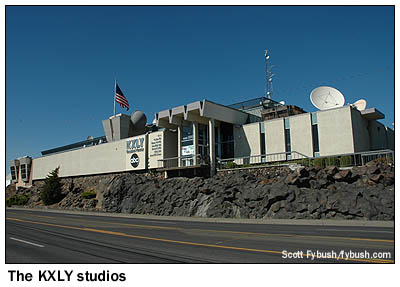 Another
few blocks to the south brings us to W. Boone Avenue, the east-west
artery that would eventually take us to Gonzaga University if
we had a reason to head in that direction.
Another
few blocks to the south brings us to W. Boone Avenue, the east-west
artery that would eventually take us to Gonzaga University if
we had a reason to head in that direction.
Instead, we stop at 500 W. Boone, where the many services of KXLY all have their studios in a big building set dramatically into a little rocky cliff.
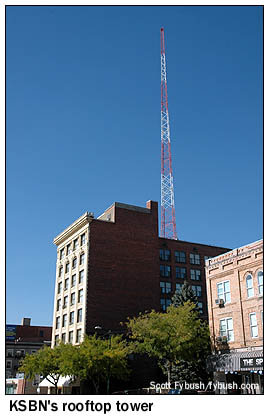 In
addition to KXLY-TV and KXMN-CA, there's news-talk KXLY (920),
sports KXLX (700 Airway Heights), top-40 KZZU (92.9), rock KHTQ
(94.5 Hayden ID), urban KEZE (96.9) and AAA-ish AC KXLY-FM (99.9),
all operated by the Spokane Television Group, a subsidiary of
the Morgan Murphy Stations, whose headquarters we saw a year
earlier when we visited Madison, Wisconsin.
In
addition to KXLY-TV and KXMN-CA, there's news-talk KXLY (920),
sports KXLX (700 Airway Heights), top-40 KZZU (92.9), rock KHTQ
(94.5 Hayden ID), urban KEZE (96.9) and AAA-ish AC KXLY-FM (99.9),
all operated by the Spokane Television Group, a subsidiary of
the Morgan Murphy Stations, whose headquarters we saw a year
earlier when we visited Madison, Wisconsin.
After KXLY, we cross the Spokane River into downtown, headed for a rare rooftop AM site. KSBN (1230) is the descendant of one of Spokane's first radio stations, experimental 7YL way back in 1921. That station became licensed as KFIO in 1923, according to Bill Harms' excellent Spokane Radio History site, later becoming KSPO, KLYK, KSPO again and eventually today's KSBN. (The KSPO calls are again in use in town, on the American Christian Network's Dishman-licensed 106.5 signal, which transmits from Beacon Hill east of Spokane.)
KFIO took an interesting route to its present class C facility on 1230: rather than having been a class IV operation on 1200 before 1941, as most of today's venerable 1230s were, it was a 100-watt daytimer on 1120, moving to 1150 in the NARBA shift of March 1941 and then to fulltime on 1230 later that year. It then moved to 1340 in 1952, when it built the current facility atop the Realty Building on E. Riverside Avenue, and back to 1230 in 1957, clearing the way for a new signal on 1330 (now KMBI) to sign on in 1959.
Not only is this an interesting rooftop tower in itself, it also sits on a historic site. Before KSPO/KLYK was at the Realty Building (now known as the Delaney Building), the facility was home to KREM, which started here on 1340, then moved to 970 from its segmented tower on Regal Street. (Indeed, the KSPO/KLYK move from 1230 to 1340 was probably an attempt to easily reuse the former KREM 1340 facility on the roof here, though a new tower apparently went up on the roof at that point.)
There were also counterpoise wires that once went from the roof of the building over Riverside Ave. and Bernard Street to adjacent buildings, but those were removed at some point between Bill's 2005 visit and our stop in 2006.
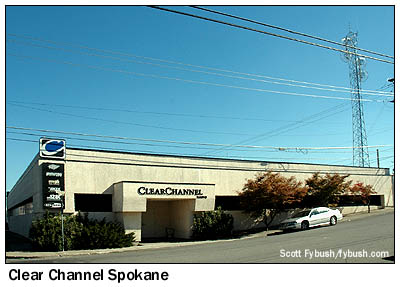
|
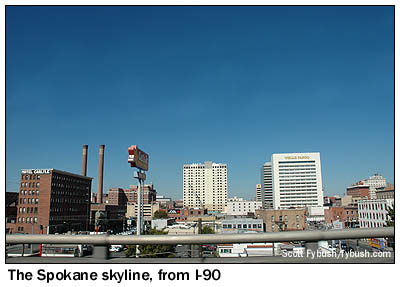
|
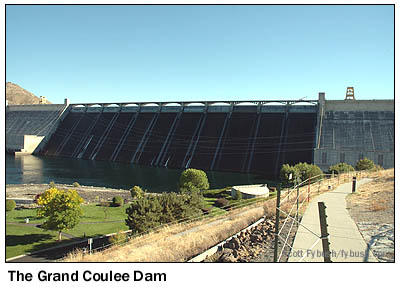 There's
one last Spokane stop to be made - a quick exterior view of the
Clear Channel studios in an industrial neighborhood at 808 E.
Sprague Avenue - before we keep heading west, first on I-90 through
the city and then on US 2 toward the Grand Coulee Dam, our next
destination.
There's
one last Spokane stop to be made - a quick exterior view of the
Clear Channel studios in an industrial neighborhood at 808 E.
Sprague Avenue - before we keep heading west, first on I-90 through
the city and then on US 2 toward the Grand Coulee Dam, our next
destination.
(Two more note before we leave Spokane: that Clear Channel cluster includes news-talk KQNT 590; progressive talk KPTQ 1280; country KIXZ-FM 96.1 Opportunity, which began in Spokane Valley as KZUN's FM sister; AC "Kiss" KISC 98.1, the old KHQ-FM; classic rock KKZX 98.9; and hot AC KCDA 103.1 Post Falls ID. And the brick building right behind the Carl's Jr. sign in the skyline shot, above right, is the old Davenport Hotel, longtime home of KHQ radio's studios and transmitters before the move to Regal Street in the fifties. Bill Harms has some great Davenport pictures on his site, too.)
It's about 90 miles from Spokane to the dam, which (at least to our eyes) doesn't look as big as you'd expect the largest concrete structure in the U.S. to look. But it does have a nice visitor center, and it would have been a shame to have come all this way and not have stopped here.
There's also radio up here in the Grand Coulee region, albeit not much of it. As we drive down highway 155 through Electric City, Washington, we pass the sign pointing the way to the studios of Wheeler Broadcasting's stations. KEYG (1490 Grand Coulee) and KEYG-FM (98.5 Grand Coulee) are still here, playing country and oldies, respectively. The third station on the sign, KZLN (97.5 Basin City), made a big move not long ago, becoming Tri-Cities-market oldies outlet KOLW under Clear Channel ownership.
The FCC's records are a little suspect up here, putting KEYG(AM)'s day site a few miles south of town and its night site near the studios, which makes no sense for a non-directional class C station, and seeing no sign of a tower near the studios, we snap our pictures and continue south down 155 to Coulee City, east on US 2, then south again on 17 to 28 and into Ephrata, one of the larger cities in the Basin region of central Washington.
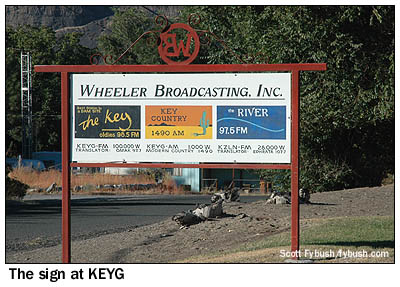
|
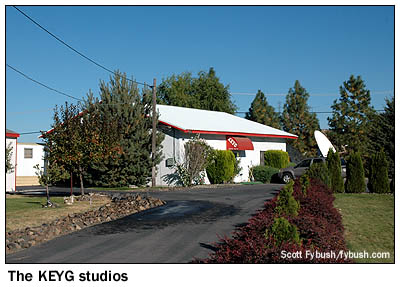
|
With daylight once again waning, we skip the very, very short tower of KTBI (810 Ephrata), a 50 kW daytimer that's also part of the American Christian Network chain that's heard all over eastern Washington, but we do stop on the west side of Ephrata for a quick look up the hill at the tower of talker KULE (730) and, beyond it, the little hill that's home to country KULE-FM (92.3), religious KTAC-FM (93.9), another link in the ACN network, and public radio KLWS (91.5), plus a bunch of translators.
Ephrata briefly had a TV station, too: KBAS-TV on channel 16 was part of a satellite network based at Yakima's KIMA-TV (Channel 29), but it didn't last very long, signing on Feb. 15, 1957 and going dark Nov. 30, 1961. Did it use this site, too?
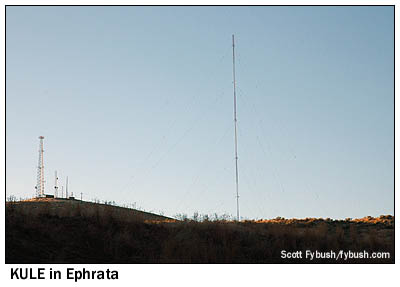
|
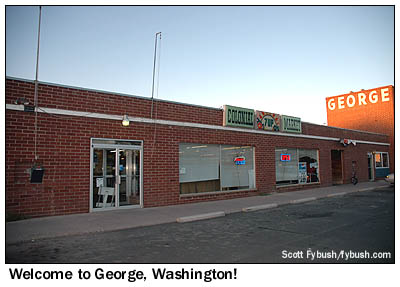
|
From Ephrata, it's a fairly short drive south to I-90, and it's right about there that we find our final stop. There's no way we can resist getting off the highway at a place called "George, Washington," even if there's not much there - a few dozen homes, a bar, and the little supermarket that doubles as the George, Washington post office, at least if you get there during the few hours it's open each day.
After George, we cross the Columbia River one last time, as the last gasps of daylight give way to a pretty moonlight vista, and an hour or so later we're in Yakima, ready for yet another day of central Washington tower-hunting, which we'll chronicle here next week. In the meantime, check out Tophour.com beginning Wednesday, April 18 to hear the legal IDs of Grand Coulee, Ephrata and Moses Lake (which we didn't get to this trip, but at least heard from a distance!)
 The
Tower Site Calendar 2007 is here! They're about to sell out,
just like 2006 did - order today at the Fybush.com
Store!
The
Tower Site Calendar 2007 is here! They're about to sell out,
just like 2006 did - order today at the Fybush.com
Store!
- Previous Site of the Week: Spokane, Washington, part I
- Next Week: Yakima, Washington
- Site of the Week INDEX!
- How can you help support Site of the Week? Click here!
- Submit your suggestions for a future Site of the Week!
